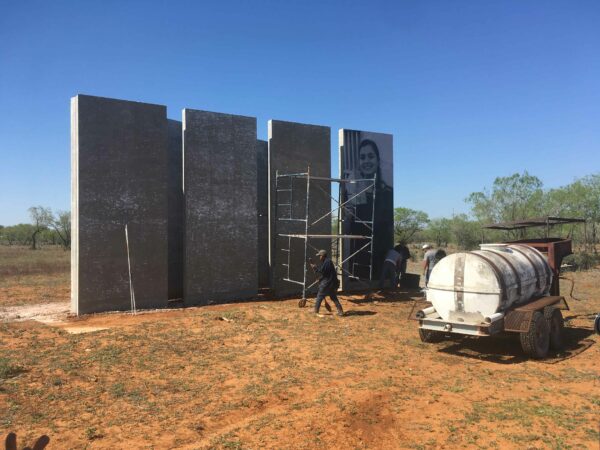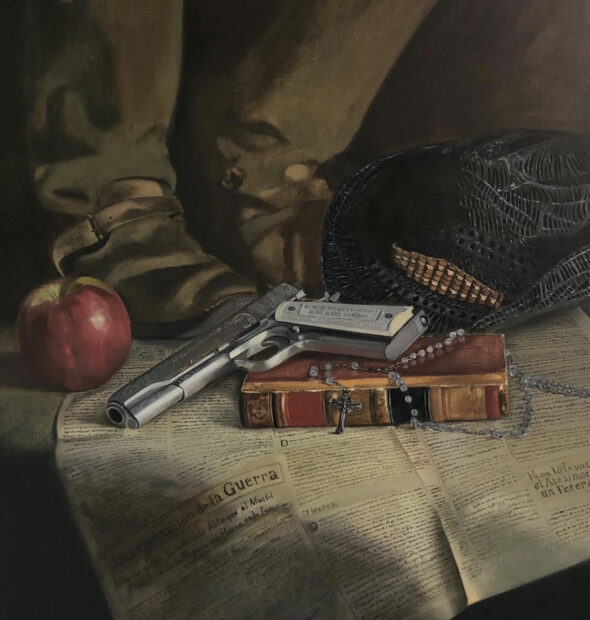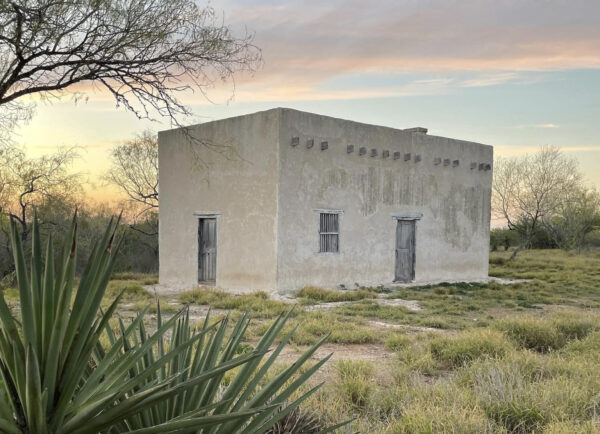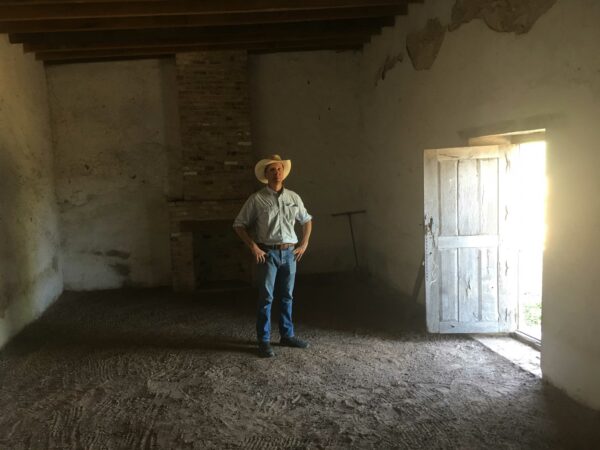
A group of men work to install the images of GeT Foundation scholarship winners off of Farm Road 1017 near Linn, Texas. Photo: Michael Flanagan.
On a rural farm road in the Rio Grande Valley, about 30 miles north of Edinburg, Texas, a group of men work to install the images of eight local artists on a series of large concrete structures. Each of the young artists to be displayed has been awarded a scholarship by the GeT Foundation. Created in 2020 to promote the arts along the borderland of South Texas and Mexico, the Guadalupe el Torrero (GeT) Foundation awards scholarships to support students and artists in pursuit of undergraduate and graduate university degrees. Founded by James McAllen, an artist and rancher, and his wife Katherine Moore McAllen, Assistant Professor of Art History and Director of the Center for Latin American Arts at the University of Texas Rio Grande Valley, the GeT Foundation also collaborates with other organizations to exhibit local art and has hosted nationally recognized artists in their spaces. Recently, I had the chance to speak with James McAllen to discuss the foundation’s history and vision for the future.
Michael Flanagan (MF): Can you talk about your background in art and how the GeT Foundation got started?
James McAllen (JM): I’m an artist and studied art at TCU, and graduated in 1996. I’ve always painted for myself, and there was a large collection of paintings in my studio that hadn’t sold. It really wasn’t important to me to sell them, but I had probably about 25 or 30 good paintings that I thought maybe I could start an art show with. So I had a pop up show in 2020 in San Antonio, and 100% of those proceeds from the show went to start funding our foundation. The show was really successful and we were able to raise $150,000.
MF: How was that money able to go toward supporting the foundation?
JM: After ten years we’ve given out around 80 scholarships. We give $1,000 to each one of these 8 students. It’s amazing what $1,000 can do; it changes lives. And I think supporting them and then showing them that we are behind them [is important], that we support them and we want to see them come back to the community someday, if that’s what they choose to do. That’s 80 kids who now have reached out to how many other kids after that? And then maybe contemporary art starts can grow organically in the Rio Grande Valley, and we’re not reliant on the museums to bring them here. We can create more of an art culture just on its own.
MF: Can you tell me about the large concrete slabs you’ve installed in Linn, Texas? From my understanding, they are somehow connected with the scholarship and the recipients. How does this program work?
JM: When we first put these up, it was very mysterious because they just sort of popped up one day; they are these giant monolithic structures along the highway. And everybody was just kind of scratching their heads thinking, “What the heck is that?” We don’t have any signage, but we wanted the images of the kids to kind of speak for themselves. To have each scholarship recipient have their own individual space. We didn’t want the foundation to get in the way of that. I love graffiti art myself, and it’s a very Shepard Fairey sort of approach to putting their work out there. I love the idea of taking a very urban art form and bringing it out to the country. We’ll see, but maybe this billboard can kind of help create an awareness of what’s going on out here in the sticks.
MF: Another one of your projects involves restoring and maintaining a series of historic structures. What has that process looked like, and how will these structures be incorporated into the foundation’s work moving forward?
JM: They’re some of the oldest structures that are, I would say, south of San Antonio and north of the Rio Grande River that are still standing. So there’s two houses here and a hand-dug well. One house was probably originally built in about 1870-1880, somewhere in there. And the other building was probably built somewhere around 1805, which makes it one of the oldest buildings in South Texas. The buildings were in pretty bad shape when I first bought the place, so we renovated them (or put them back together), using materials strictly from the ranch. We didn’t run out to Home Depot and go buy cement and blocks and things like that; we built all the material here.
So, we excavated all the limestone. We made all the mortar and the stucco, and we put everything back together. Now, I don’t know if that’s exactly the way it was, and I didn’t want to reinterpret things. I just wanted to kind of keep the structures from falling down, and I think we’ve successfully done that. So this is our foundation headquarters and we hope to someday build some sort of area where people host conferences or symposia or maybe a gallery. You know, some sort of function where people can come out here and maybe look at contemporary art and learn about the history of South Texas. It allows us to have an appreciation for the past, but also to look forward to the future. Whether it’s somebody just down the road who might be an artist over in San Ysidro or in Star County, or maybe somebody from New York City or Mexico City.
MF: You have a fascinating personal connection to this land. How does that tie into your vision for the GeT Foundation?
JM: What we’re on right now is the San Ramon Grant, established in 1804. The grant next door is my family’s grant, which is the Santa Anita Grant — that was established in 1791 and was granted to an ancestor of mine by the name of Manuel Gomez. The McAllen part of it — John McAllen immigrated to this country from Ireland in the late 1830s. He was only 14 years old at the time and immigrated into the United States, and found his way down into South Texas. That was a very turbulent time because of the Mexican-American War, and he spent some time in jail in Matamoros because they thought he was a spy for the U.S. Army. When he was released from jail, he established himself in Matamoros and worked for a mercantile at the age of 15 or 16. He was an orphan, and his travels over to the United States were paid for by a great uncle of his. I think things were just so bad in Europe at the time, it was just better to get on a boat and get over to the United States no matter what happened. So he did, and eventually landed in Brownsville, and I think he was trying to go further west.
Interestingly, a lot of people don’t know this, but Roma, Texas was actually a staging point for people traveling. It was sort of like an inland port for people traveling to California, because you couldn’t go through the Midwest. There was a lot of violence between Native Americans and the U.S. Cavalry at the time, and it just wasn’t safe. So they would actually travel through northern Mexico to get to California. And I think Roma was one of those staging points.
A lot of people don’t realize how chaotic the 19th century was in South Texas. There is a 100-year time span where South Texas was a pretty happening place. One day they’re under the Spanish crown, then they’re under the French crown, then they’re under the rule of Mexico, and now they’re Texan. So when I look at this land I can see the story. You can see proof of people immigrating in from Mexico and establishing themselves north of the river. And that’s kind of the history part of the GeT Foundation. This is our headquarters and we like to talk about that early history to show that people in this community have an important history that is also important to the larger history of the United States.
MF: How do you think the GeT Foundation might be able to challenge the mainstream narrative around what this part of the country is known for? Particularly in regard to its relationship with Mexico.
JM: The border gets a bad rap because of what has been happening the last few years. I’m from the Rio Grande Valley and I love it here. My family’s been here for generations and I don’t plan on going anywhere. So what I’m trying to do is build something here. If someone can’t live in Houston, New York, or Miami, maybe I can bring a little bit of that here and share it with the community. We hope to have an artist residency someday to try to paint a friendlier picture of the relationship with our southern neighbor than what we see here today. To tell a larger story of what this area of South Texas is really about, and its early history, because we do have a fantastic history here. That history is also equally as interesting as any history that might, say, be on the East Coast or somewhere like that. I think it begins with the students and approaching them on a more grassroots level. You could have gallery tours and that sort of thing, but I think if we’re not supporting the students and schools, then I don’t think it’s sustainable.
The GeT Foundation was recently awarded a grant by The Raul & Hortensia Tijerina Foundation and is currently in the process of announcing its 2024 scholarship recipients. Follow the GeT Foundation at www.gettexasart.org to learn more.






1 comment
James thanks for sending this very informative description of what you are bringing about down south. I applaud your efforts! Art is what’s needed there and everywhere,especially in these troubled times. It’s always good to hear some good news from the border. Jim